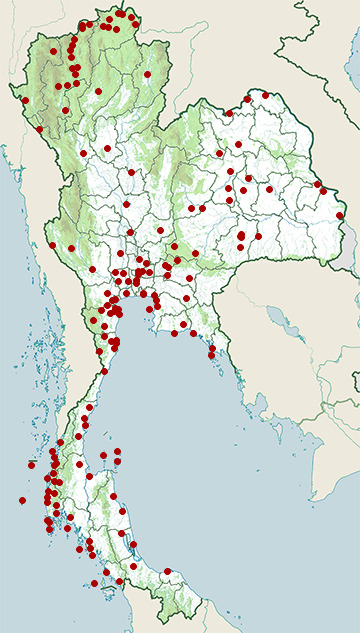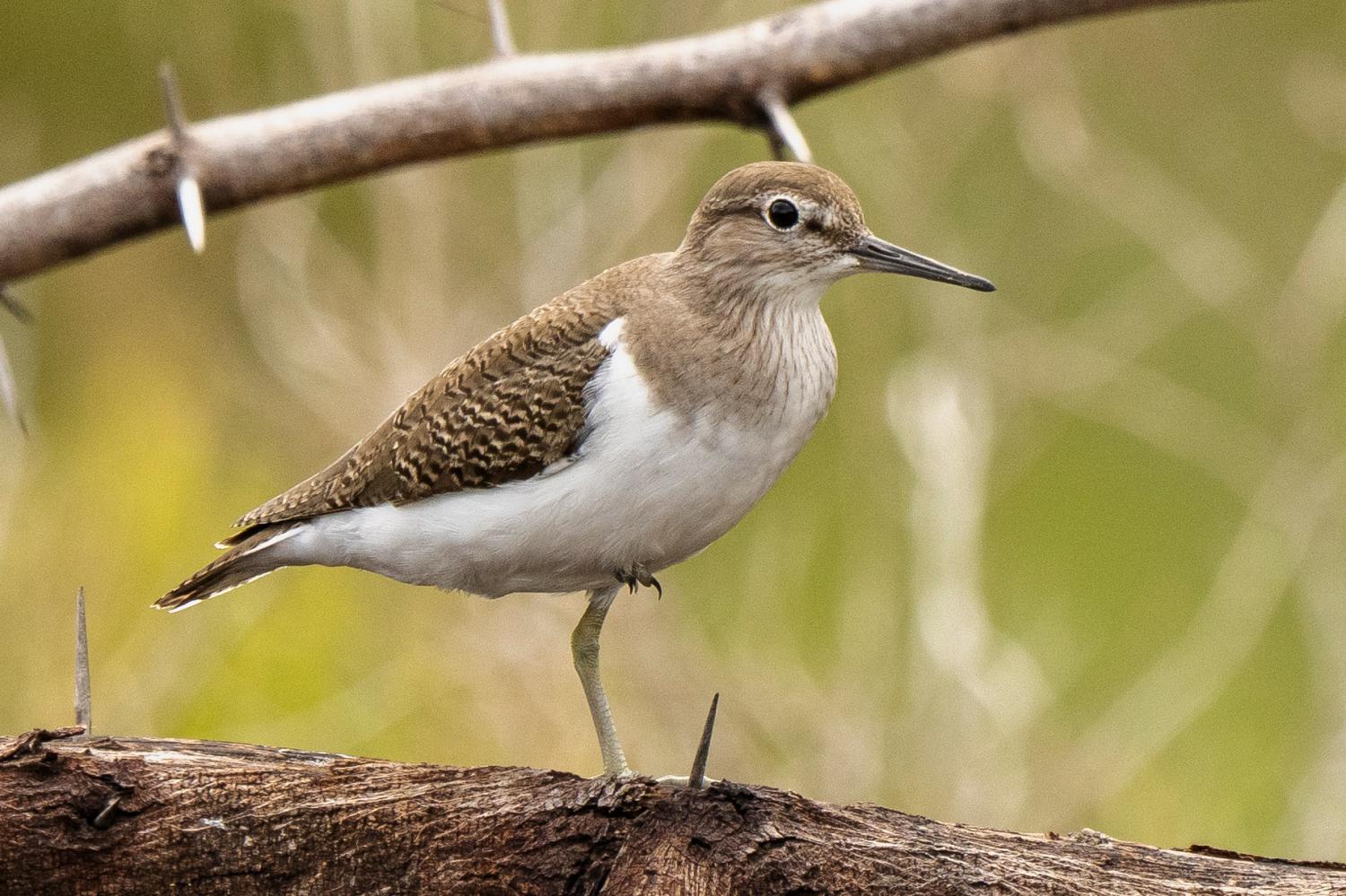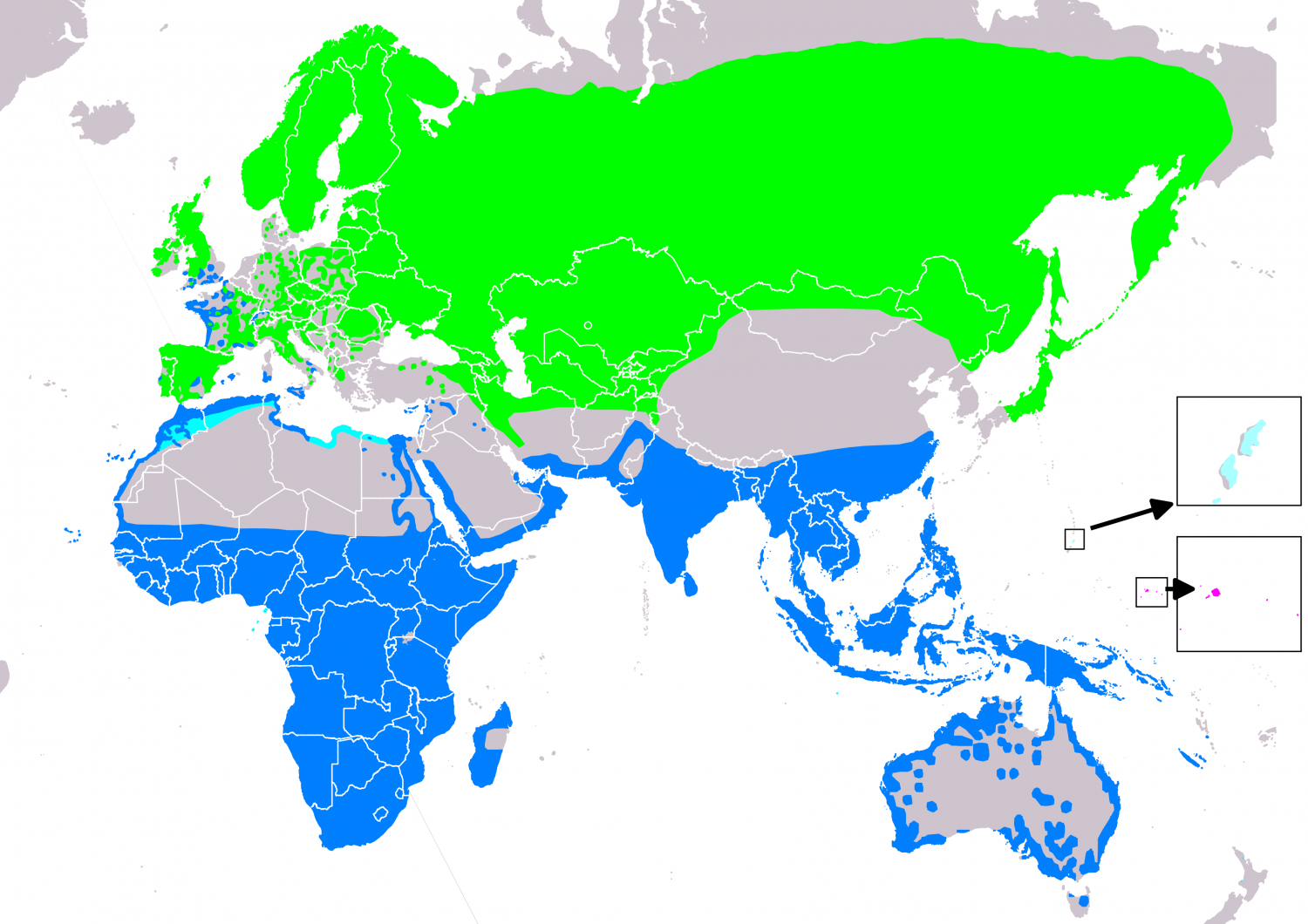Species of Thailand
Common sandpiper
Actitis hypoleucos
Carolus Linnaeus, 1758
In Thai: นกเด้าดิน
The common sandpiper (Actitis hypoleucos) is a small Palearctic wader. This bird and its American sister species, the spotted sandpiper (A. macularia), make up the genus Actitis. They are parapatric and replace each other geographically; stray birds of either species may settle down with breeders of the other and hybridize. Hybridization has also been reported between the common sandpiper and the green sandpiper, a basal species of the closely related shank genus Tringa.
Taxonomy
The common sandpiper was one of the many bird species originally described by Carl Linnaeus in his landmark 1758 10th edition of Systema Naturae, where it was given the binomial name of Tringa hypoleucos. The current scientific name is from Ancient Greek. Actitis is from aktites, "coast-dweller" derived from akte, "coast", and hypoleucos is from hupo, "beneath", and leukos "white".
Description
The adult is 18 – 20 cm long with a 32 – 35 cm wingspan. It has greyish-brown upperparts, white underparts, short dark-yellowish legs and feet, and a bill with a pale base and dark tip. In winter plumage, they are duller and have more conspicuous barring on the wings, though this is still only visible at close range. Juveniles are more heavily barred above and have buff edges to the wing feathers.
This species is very similar to the slightly larger spotted sandpiper (A. macularia) in non-breeding plumage. But its darker legs and feet and the crisper wing pattern (visible in flight) tend to give it away, and of course they are only rarely found in the same location.
Ecology
It is a gregarious bird and is seen in large flocks, and has the distinctive stiff-winged flight, low over the water, of Actitis waders. The common sandpiper breeds across most of temperate and subtropical Europe and Asia, and migrates to Africa, southern Asia and Australia in winter. The eastern edge of its migration route passes by Palau in Micronesia, where hundreds of birds may gather for a stop-over. They depart the Palau region for their breeding quarters around the last week of April to the first week of May.
The common sandpiper forages by sight on the ground or in shallow water, picking up small food items such as insects, crustaceans and other invertebrates; it may even catch insects in flight. In the Nukumanu language of the Nukumanu Islands (Papua New Guinea), this species is usually called tiritavoi. Another Nukumanu name for it, matakakoni, exists, but this is considered somewhat taboo and not used when children and women are around. The reason for this is that matakakoni means "bird that walks a little, then copulates", in reference to the pumping tail and thrusting head movements the Actitis species characteristically perform during foraging.
It nests on the ground near freshwater. When threatened, the young may cling to their parent's body to be flown away to safety.
The common sandpiper is one of the species to which the Agreement on the Conservation of African-Eurasian Migratory Waterbirds (AEWA) applies.
It is widespread and common, and therefore classified as a species of least concern by the IUCN but is a vulnerable species in some states of Australia.
This article uses material from Wikipedia released under the Creative Commons Attribution-Share-Alike Licence 3.0. Eventual photos shown in this page may or may not be from Wikipedia, please see the license details for photos in photo by-lines.
Category / Seasonal Status
Wiki listed status (concerning Thai population): Winter visitor
BCST Category: Recorded in an apparently wild state within the last 50 years
BCST Seasonal status: Non-breeding visitor
Scientific classification
- Kingdom
- Animalia
- Phylum
- Chordata
- Class
- Aves
- Order
- Charadriiformes
- Family
- Scolopacidae
- Genus
- Actitis
- Species
- Actitis hypoleucos
Common names
- English: Common sandpiper
- French: Chevalier guignette
- Thai: นกเด้าดิน
Synonyms
- Tringa hypoleucos hypoleucos, Charles Gald Sibley & Burt Leavelle Monroe (1990)
- Tringa hypoleucos hypoleucos, Evan Graham Turbott (1990)
- Tringa hypoleucos hypoleucos, S. Cramp & K. E. L. Simmons (1977)
- Tringa hypoleucos, Carolus Linnaeus (1758)
Conservation status

Least Concern (IUCN3.1)
Photos
Please help us review the bird photos if wrong ones are used. We can be reached via our contact us page.
Range Map

- Amphawa District, Samut Songkhram
- Ang Thong National Marine Park
- Ao Phang-Nga National Park
- Ban Laem District, Phetchaburi
- Ban Lat District, Phetchaburi
- Ban Lueam District, Nakhon Ratchasima
- Ban Phai District, Khon Kaen
- Ban Sang District, Prachinburi
- Bang Len District, Nakhon Pathom
- Bang Pakong District, Chachoengsao
- Bang Phra Non-Hunting Area
- Bang Pu Recreation Centre
- Bangkok Province
- Borabue District, Maha Sarakham
- Bueng Boraped Non-Hunting Area
- Chaiya District, Surat Thani
- Chanuman District, Amnat Charoen
- Chatturat District, Chaiyaphum
- Chiang Dao District, Chiang Mai
- Chiang Dao Wildlife Sanctuary
- Chiang Khong District, Chiang Rai
- Chiang Saen District, Chiang Rai
- Doi Inthanon National Park
- Doi Lo District, Chiang Mai
- Doi Pha Hom Pok National Park
- Doi Tao District, Chiang Mai
- Fang District, Chiang Mai
- Hat Chao Mai National Park
- Hat Wanakon National Park
- Hat Yai District, Songkhla
- Hua Hin District, Prachuap Khiri Khan
- Huai Chorakhe Mak Reservoir Non-Hunting Area
- Huai Talat Reservoir Non-Hunting Area
- In Buri District, Sing Buri
- Kabin Buri District, Prachinburi
- Kaeng Krachan National Park
- Kamphaeng Saen District, Nakhon Pathom
- Kantharawichai District, Maha Sarakham
- Kapong District, Phang Nga
- Khao Laem Ya - Mu Ko Samet National Park
- Khao Lak - Lam Ru National Park
- Khao Sam Roi Yot National Park
- Khao Sok National Park
- Khao Yai National Park
- Khao Yoi District, Phetchaburi
- Khemarat District, Ubon Ratchathani
- Khlong Luang District, Pathum Thani
- Khlong Nakha Wildlife Sanctuary
- Khung Kraben Non-Hunting Area
- Khura Buri District, Phang Nga
- Klaeng District, Rayong
- Ko Chang National Park
- Ko Lanta National Park
- Ko Libong
- Ko Phayam
- Ko Phra Thong
- Ko Samui District, Surat Thani
- Ko Sichang District, Chonburi
- Kui Buri National Park
- Kumphawapi District, Udon Thani
- Kut Thing Non-Hunting Area
- Laem Ngop District, Trat
- Laem Pak Bia
- Laem Son National Park
- Lam Nam Kok National Park
- Mae Ai District, Chiang Mai
- Mae Chan District, Chiang Rai
- Mae Moei National Park
- Mae Rim District, Chiang Mai
- Mae Taeng District, Chiang Mai
- Mu Ko Chumphon National Park
- Mu Ko Phetra National Park
- Mueang Buriram District, Buriram
- Mueang Chiang Mai District, Chiang Mai
- Mueang Chiang Rai District, Chiang Rai
- Mueang Chonburi District, Chonburi
- Mueang Kanchanaburi District, Kanchanaburi
- Mueang Khon Kaen District, Khon Kaen
- Mueang Krabi District, Krabi
- Mueang Lampang District, Lampang
- Mueang Lamphun District, Lamphun
- Mueang Nakhon Nayok District, Nakhon Nayok
- Mueang Nakhon Pathom District, Nakhon Pathom
- Mueang Nan District, Nan
- Mueang Nong Khai District, Nong Khai
- Mueang Nonthaburi District, Nonthaburi
- Mueang Pathum Thani District, Pathum Thani
- Mueang Pattani District, Pattani
- Mueang Phang Nga District, Phang Nga
- Mueang Phetchaburi District, Phetchaburi
- Mueang Phichit District, Phichit
- Mueang Phuket District, Phuket
- Mueang Ranong District, Ranong
- Mueang Ratchaburi District, Ratchaburi
- Mueang Samut Sakhon District, Samut Sakhon
- Mueang Samut Songkhram District, Samut Songkhram
- Mueang Satun District, Satun
- Mueang Sukhothai District, Sukhothai
- Mueang Suphanburi District, Suphan Buri
- Mueang Surat Thani District, Surat Thani
- Mueang Surin District, Surin
- Mueang Tak District, Tak
- Non Sang District, Nong Bua Lamphu
- Nong Bong Khai Non-Hunting Area
- Nong Song Hong District, Khon Kaen
- Nong Ya Plong District, Phetchaburi
- Nong Yai Area Development Project Under Royal Init
- Pa Sak Chonlasit Dam Non-Hunting Area
- Pai District, Mae Hong Son
- Pak Chong District, Nakhon Ratchasima
- Pak Phanang District, Nakhon Si Thammarat
- Pak Phli District, Nakhon Nayok
- Pak Thale
- Pathio District, Chumphon
- Pha Daeng National Park
- Pha Taem National Park
- Phi Phi Islands
- Phra Nakhon Si Ayutthaya District, Phra Nakhon Si Ayutthaya
- Phutthamonthon District, Nakhon Pathom
- Pran Buri District, Prachuap Khiri Khan
- Pran Buri Forest Park
- Rattanawapi District, Nong Khai
- Sakaerat Environmental Research Station
- Salawin National Park
- Samut Prakan Province
- San Sai District, Chiang Mai
- Sanam Bin Reservoir Non-Hunting Area
- Sathing Phra District, Songkhla
- Sikao District, Trang
- Similan Islands
- Sirinat National Park
- Sri Nakarin Dam National Park
- Sri Phang Nga National Park
- Suk Samran District, Ranong
- Surin Islands
- Takua Pa District, Phang Nga
- Tarutao National Marine Park
- Tha Sala District, Nakhon Si Thammarat
- Tha Takiap District, Chachoengsao
- Tha Yang District, Phetchaburi
- Thai Mueang District, Phang Nga
- Thalang District, Phuket
- Thale Noi Non-Hunting Area
- Than Sadet - Koh Pha-Ngan National Park
- Thanyaburi District, Pathum Thani
- Thao Kosa Forest Park
- Thawat Buri District, Roi Et
- Thong Pha Phum National Park
- Thung Tako District, Chumphon
- Wang Noi District, Phra Nakhon Si Ayutthaya
- Wat Phai Lom & Wat Ampu Wararam Non-Hunting Area
- Wiang Chai District, Chiang Rai
- Wiang Kaen District, Chiang Rai

